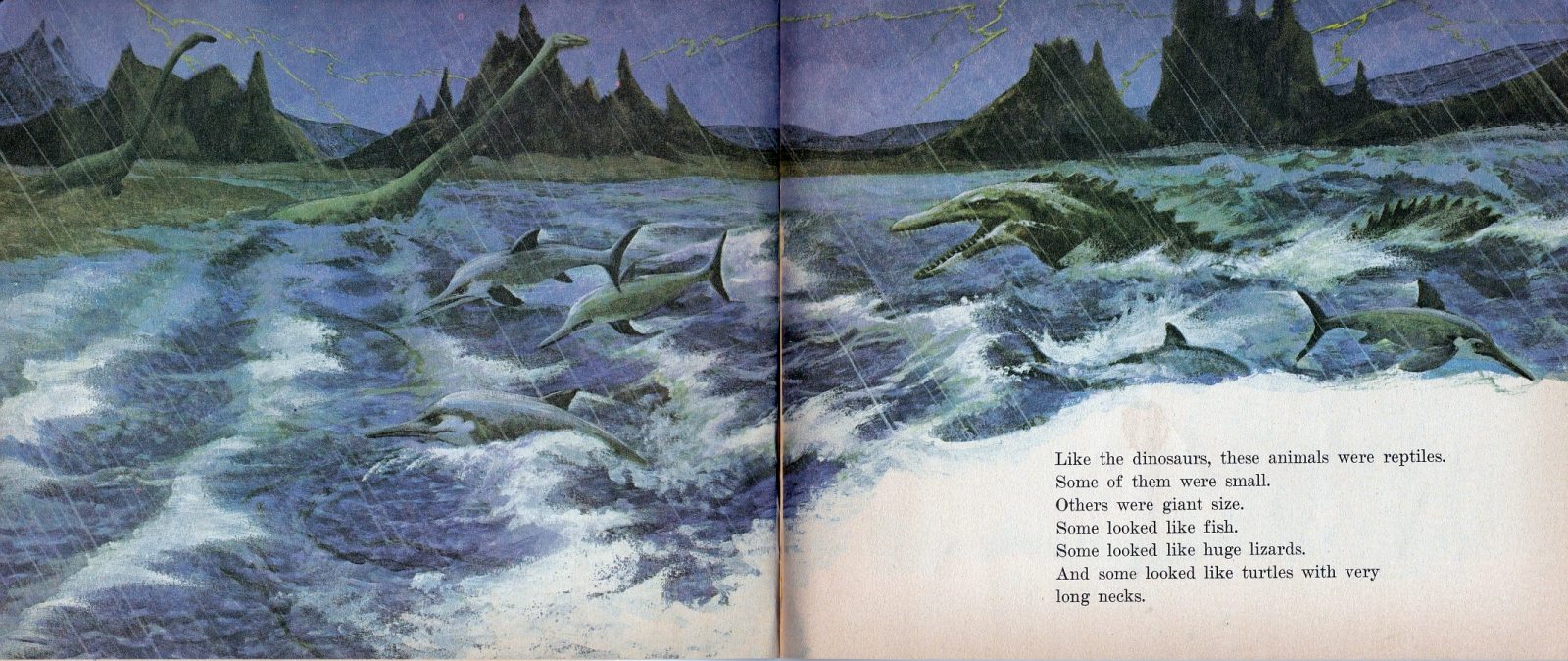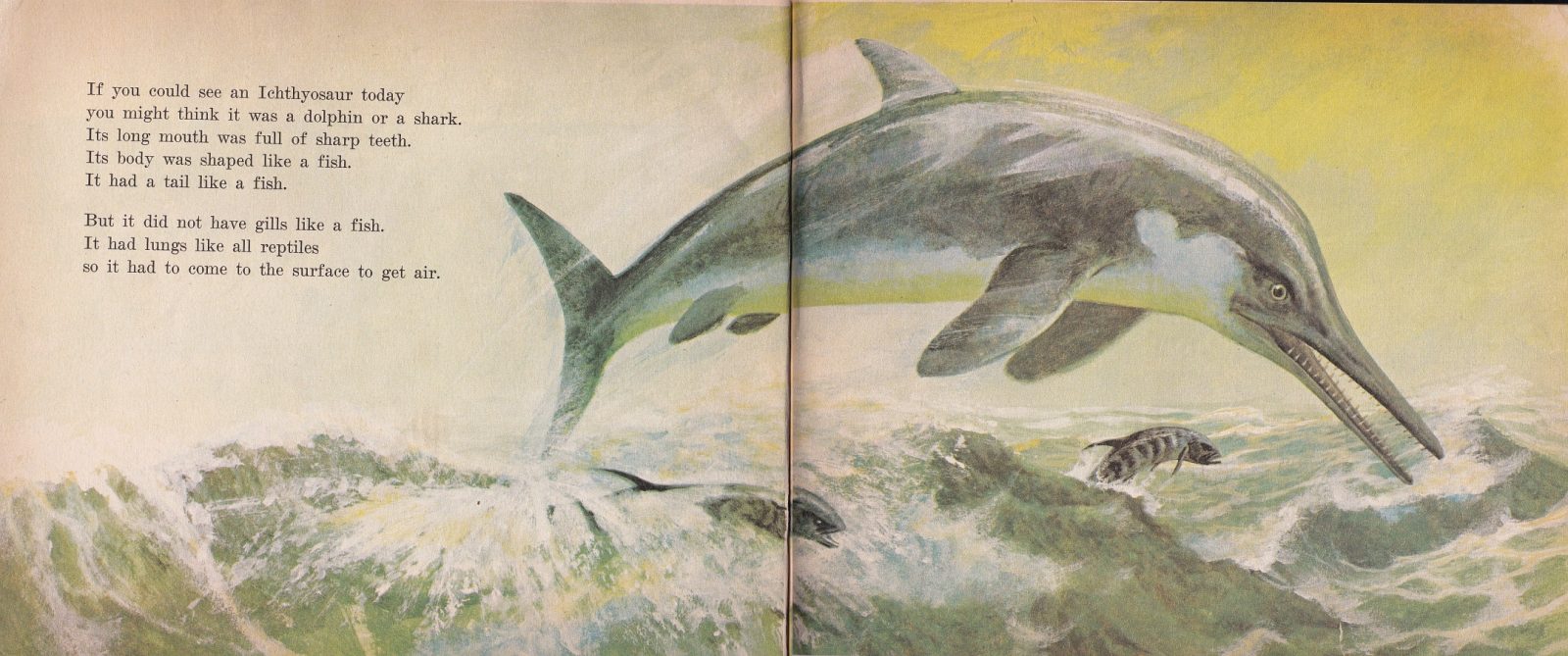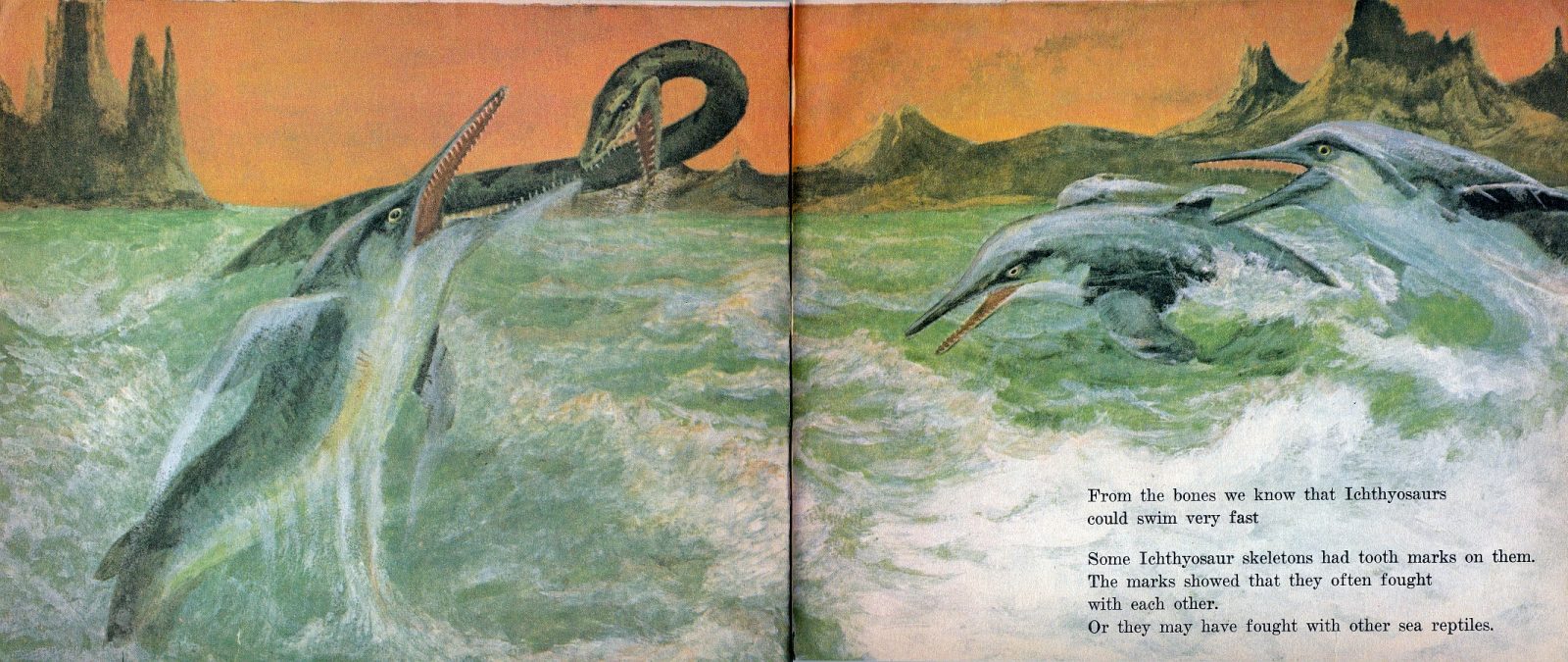Mesozoic marine reptiles have been popular subjects in illustration since the Dawn of Palaeoart, with artists keen to emphasise their monstrous strangeness and savagery, and the primordial nature of the world they lived in. Such is most definitely the case here, in 1977’s Sea Monsters of Long Ago (clue’s in the title), published by Scholastic Book Services, written by Millicent E Selsam, and illustrated by John Hamberger. (Mmm…Hamberger.) Although this is a book clearly aimed at young children, Hamberger doesn’t hold back in making the artwork fantastically moody and evocative. And there’s even a dinosaur in it (sensu stricto), so you can spare your disgruntled comments.

The cover art sells the book beautifully, depicting as it does that classic clash of the titans – a mosasaur taking on an elasmosaurid plesiosaur. The scene feels alive and full of energy, the animals churning up the sea and splashing foam everywhere; the water streaming from the creatures as they erupt from the waves is especially well done. Dimly lit by an orange sun, the alien nature of this world is further emphasised by the highly dramatic and aggressively jagged rocks that form the backdrop.
Now, this is a book that’s very much of its time when it comes to the anatomy and appearance of prehistoric marine reptiles, so you can expect to see plenty of mosasaurs with crests running down their backs, plesiosaurs arcing their necks out of the water, and so on and so forth. There are even…

…Plesiosaurs on land! Quite why they’re on land isn’t mentioned, although of course it was assumed for a long time that plesiosaurs had to come onto land to lay eggs, like turtles, until evidence of live birth at sea was discovered. I love the ichthyosaurs leaping from the surf, and the especially sea-monster-like mosasaur that seems to be chasing them, water streaming from its gaping maw. More than that, those jagged rocks are back, and just look at the weather! It simply doesn’t get any more Savage Prehistoric Lost World than having the rain lashing down and forks of lightning shooting across the sky. Beautiful.

Naturally, the ichthyosaurs appear – to a modern eye – more ‘naturalistic’ and true-to-life than the plesiosaurs and mosasaurs. You can thank the exceptional preservation of soft tissue outlines, and their discovery quite early on, for that. They’re also inevitably countershaded, which might seem a little unimaginative, but then it’s also very likely. The above illustration depicts a single unspecified “ichthyosaur” – probably intended to be Ichthyosaurus itself, it seems a reasonable fit for the animal as classified today, even after meticulous cleanups of its overfilled wastebasket. Again, it shows off Hamberger’s skill at painting movement through water, and the animal looks suitably mean ‘n’ moody. Everything here looks mean ‘n’ moody.

After the ichthyosaur’s introduction, we see it taking on an extremely serpentine plesiosaur beneath a dusty, ochre sky, with yet more barren, spiked mountains in the distance. It looks almost like an alien planet. Can’t argue with that water, though.

Unusually, the book mentions a few ichthyosaur genera besides Ichthyosaurus itself, including Opthalmosaurus, Eurhinosaurus, and “Leptopterygius”, for which you can almost certainly read Temnodontosaurus in this case (look, I didn’t just check this on Wikipedia, I spoke to a marine reptile researcher and everything. So there). Temnodontosaurus was indeed rather large and frightening-looking, as emphasised here by giving it a pronounced brow ridge to make its already angrily staring eye extra intimidating. With the animal fully submerged, there’s no frothing, churning sea here – but we are treated to light playing over the animal’s back, forming a reticulated pattern. There isn’t much to see in the background, but the animal’s scale is conveyed by the fish surrounding it, and the way that its tail disappears away from the viewer.

On to plesiosaurs now, and another scene that looks like a vision of an alien world, complete with slightly fantastical jagged peaks on the rocks. You could also describe it as having a fairy-tale quality – I think Anton Pieck would have approved. Again, both the sky and water are beautifully painted (the reflections in the water! The fog!), while the animals appear simply surreal. It definitely stokes the imagination.

Naturally, Elasmosaurus receives special attention – and a double page spread, once again set in a world where the sun is permanently setting (or rising? Or setting again?) on the saurian empire. I’m almost more drawn to the forbidding, smoking wastelands in the background than the animals themselves at this point, although a good impression is given of the beasts’ sheer length, and quite how silly their necks were. In particular, note how the foreground animal’s body is fully on the left page, while its neck stretches impressively far out into the right, in spite of the fact that it turns vertically upwards at one point.

Short-necked plesiosaurs get a look in, too. Here’s Kronosaurus, “the biggest one of these” which was “the size of an average whale.” Whatever an ‘average’ whale is. I imagine this is based on the Harvard ‘Plastersaurus’ mount, which was lengthened so much that a champagne fridge and quilted leather bench could comfortably have been installed inside it. Lovely bubbles and reflecting light once again, but has the Kronosaurus’ eye been inserted into the wrong hole in its head? Easy mistake to make.
As for the slightly longer-necked fellow being chased, it’s probably supposed to be a leptocleidid, although the book doesn’t say.

And finally…here’s that dinosaur I promised! Yes, it’s a bird, I’m sorry. In fact, it appears to be a hesperornithid of some sort, which having just caught a fish is now in danger of being devoured itself. In spite of the S-necked, occasionally land-hopping plesiosaurs, this extremely croc-like Tylosaurus might be the most bizarre-looking reconstruction in the book to a modern viewer. It’s even a little off-kilter with the somewhat more typical, frill-backed mosasaurs that appear elsewhere, which at least appear to have gums. If anything, it’s more crocodilian than serpentine, which is rather odd to say the least (especially given the description here); admittedly, foreshortening might make the tail appear shorter than it otherwise would have.
This isn’t quite the end – the book briefly mentions the Komodo dragon (as a relative of mosasaurs), before presenting another orange-lit open ocean scene with a variety of bizarre reptiles sticking their heads above water, and the following text:
“What happened to Tylosaurus and all the other strange reptiles that lived in the sea?
They swam in the oceans of the world until about 70 million years ago.
Then they disappeared, just as the dinosaurs did.
Nobody knows why.”
And that’s it. What a fittingly haunting way to finish things off.







2 Comments
albertonykus
September 29, 2022 at 7:00 pmThat one dinosaur is quite good, too, even by modern standards! Note the anhinga-like fan of tail feathers, which was originally.suggested by Marsh to have been present based on the anatomy of the tail vertebrae, but rarely seen in depictions of Hesperornis nowadays.
oliveunicorn
October 17, 2022 at 10:15 pmI love vintage art like this. Made the ancient seas seem so scary ! also hope you don’t mind I’m linking your blog in a post of mine.